Featured This Month
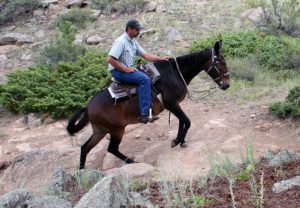
MULE CROSSING: On the Trail with Mules
By Meredith Hodges With the hectic schedule of spring and summer slowly tapering into fall, thoughts of cool, refreshing mountain streams, the sight of a massive bull elk, or the quiet majesty of the rugged mountain peaks on a relaxing trail ride, mountain hunt or pack trip begin to ease their way into our minds. What better time to share with your mule or donkey? What better place for him to show you what he was born to do? A mountain trail ride or pack trip are both perfect ways for you to get to really know your Longears and strengthen the bond between you. Mules are remarkably strong and durable animals, making them excellent mountain partners. The cupped shape of their hooves allows them to track the rough mountain terrain with much more surefootedness than their counterpart, the horse. A mule’s superior intelligence and strong sense of survival help him to carefully negotiate the placement of his feet, insuring the safest ride possible. This is both important and comforting to know when heading for the mountains. The mule’s strength and endurance are sometimes unbelievable, but always dependable. On a hunting trip, he will take you through rough mountain terrain ...
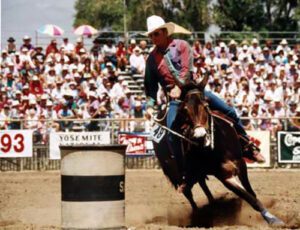
MULE CROSSING: Surge of Mule Shows
By Meredith Hodges I remember back in 1982 when summer came and we had to search high and low for shows in which we could compete with our mules! As they say, "You've come a long way, baby!" Mule shows are now so numerous that it is becoming very difficult to decide which ones to attend. Years ago, our mules were not necessarily welcome at horse competitions, and today that has changed as well – making our decisions about where to compete is even more complicated. It is truly amazing to see the tremendous growth in popularity of the mule over the past 30 to 40 years, but then I guess it was inevitable given all their redeeming qualities! It really isn't that unusual that people would begin to prefer mules once they received accurate and truthful information about them. Granted, you have to be smarter than the mule in order to train one, but once you train one properly, you have a wonderful companion and a top competitor in the equine world. More and more, the criticism of mules has changed to general curiosity and a willingness to learn more about these unique animals. Many people have taken a ...
All Articles
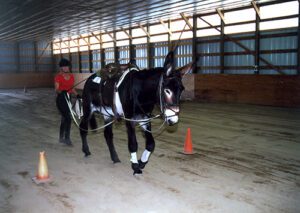
MULE CROSSING: Donkey Training, Part 4
By Meredith Hodges You have, thus far, begun to teach your donkey several things: how to begin to execute the turn on the forehand and turn on the haunches, how to walk forward in a round pen from the lunge whip without a saddle or harness (then with the saddle and harness), on the drivelines, and while being ridden. He has also begun to learn how to “trot on” from the lunge whip while tacked up, and how to walk and trot on the lead with an assistant aiding from behind. Do not be alarmed if your donkey’s movements are not perfect. Each time you work with him, he will get better at each of these things, especially if, at the start of each lesson, you review before adding anything new. At the next lesson, if he is large enough, he will learn to trot with a rider onboard. If he is too small to ride, skip this lesson under saddle and do it with the drivelines. As always, begin with a complete review. After he has done his turns on the forehand and haunches, walked both on the lunge and with the drivelines, done right and left turns both on the drivelines and with a rider, and trotted with tack, he is ready to trot with a rider. Before you begin, here is a little exercise you can use to help your donkey stay light in the bridle. When you have mounted, take a treat in your right hand and your right rein in your left hand, and ask him to bring his head around to your knee and take the treat from your hand. Then take the treat in your left hand and the left rein in your right hand, and ask him to bend his head around ...
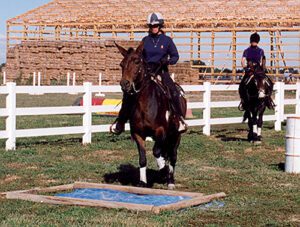
MULE CROSSING: Donkey Training, Part 5
By Meredith Hodges By now your donkey should be getting much better at his turns on the forehand and haunches on the lead line. He should be leading easily at the walk and trot and squaring up while stopped. He should be lunging at the walk and trot in the round pen, and ground-driving at the walk in the round pen, both straight and through turns and reverses. He should be walking and trotting with a rider in the round pen, without the assistant. He should be both ground-driving and walking with a rider through the hourglass pattern and on the perimeter of the larger arena. Now you are going to ask for a little more detailed control by asking him to walk over and through some very straight-forward obstacles. Set up some obstacles in a confined area. Obstacles might include a tarp, four ground rails, a bridge, a straight back-through, a mailbox and a tractor tire. Your donkey should have been led through these obstacles as part of his leading training, so he should be familiar with these obstacles. Now you can begin to ask him to negotiate these obstacles more on his own by first ground-driving him through them, then (if he is large enough) by riding him through them. Begin by reviewing his turns on the forehand and haunches. Then attach the drivelines and have your assistant lead him as you drive him from behind. Start with something simple such as ground poles, a tarp or a bridge that he can easily walk over. If he is negotiating the tarp or bridge, ask him to “whoa” when he is standing on it with all four feet, reward him and then proceed. If he is negotiating the ground poles, walk over them. Once he is on the other ...
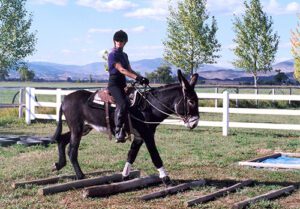
MULE CROSSING: Donkey Training, Part 6
By Meredith Hodges By walking your donkey through all the different phases of training, and before going on to the trot, you have given yourself and your donkey an opportunity to learn to negotiate and perfect your movements before you ask for speed. This allows for a lot more perfection of coordination to take place, so things are less likely to fall apart when you do add a little speed. This is the most obvious difference between mules or horses and donkeys. Horses and mules are difficult to slow down in training because of their flight instinct and are better equipped to handle walk, trot and canter all at once, moving from a confined area to more space and, ultimately, through obstacles. Donkeys, however, with their freeze instinct, get worried and won’t move if they are overwhelmed and confused. For this reason, their training is approached a little differently. By now, your donkey should be walking really well in the round pen, both lunging and in the drivelines, on straight-aways and turning. He should be walking the hourglass pattern and the perimeter of the larger arena, circling at the cones in the pattern, doing circles off the wall on the perimeter of the arena, and crossing straight diagonals for changes of direction. He should be walking through straight-forward obstacles and getting in and out of your trailer. He should be moving away from pressure a lot more easily through the turns on the forehand and haunches while on the lead line. Next, you will ask our donkey to begin to do his turn on the haunches while on the drivelines. This will take place in the round pen. You have already asked for the reverse and smooth turns with which he should be familiar. Now, you are going to ask ...
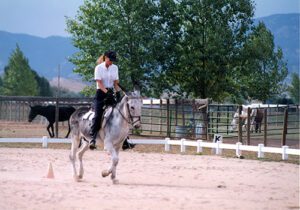
MULE CROSSING: Donkey Training, Part 7
By Meredith Hodges If your donkey has any problems with the trot after the previously described exercises, it will probably be in the hourglass pattern while under saddle. If he has difficulty maintaining the trot through the turns and serpentines through the middle, and continues to bulge either one way or the other, you can try one more thing to help him. Have your assistant ride a seasoned animal through the pattern ahead of you while you follow a few strides behind. Don’t ride too close, or too far away. Your donkey should be more than willing to follow. After all, doing things with friends is always more appealing. When his trot work is going well, it is time for your donkey to learn to canter. Begin with a complete review in the round pen—lunging at the walk and trot, ground-driving at the walk and trot, turns at the walk and trot, and riding at the walk and trot. Then dismount and try lunging, first at the trot, then ask him to “Canter.” Use the same cues you did at the walk and trot. Give the verbal command first, then shuffle your feet while raising both of your arms, one pointing in the direction in which you wish to travel, and the other one raised behind you, with the whip in-hand. If he does not comply, then lightly tap the whip to his gaskins once just above the hock, then tap it harder on the fence behind him. He should begin to canter. Even if he canters only two steps, stop him, reward him and then try again. Don’t keep asking for more right away, because he will only get frustrated and stop. If you are patient and consistent, he will canter farther each time. Once he canters fairly well ...
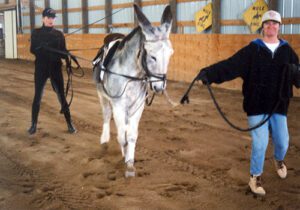
MULE CROSSING: Donkey Training, Part 8
By Meredith Hodges Now it is time for your donkey to learn to move laterally. Lateral movements are essential to the overall balance and posture of your donkey. It will improve muscle strength throughout his body and will reduce the risk of injury or soreness while he is being ridden or driven. You can begin his lateral work on the drivelines in the large arena. Begin by driving your donkey through the hourglass pattern (after review). As he approaches the first corner cone, ask him to circle it and then turn down the centerline instead of moving down the short side to the next cone. Let him move straight for a few steps, and then, with your assistant at his head, ask him to move forward and sideways away from your circle. The centrifugal force from the circle should send him onto the diagonal with little resistance and your assistant will be in front to keep him from just running forward. If he is to move laterally to the right, you should make a small circle to the left and drift out and onto the right diagonal. If he is to move laterally to the left, you should circle to the right and allow him to drift out and onto the left diagonal. As your donkey is on the circle, maintain the bend with a shortened inside rein. As he comes up the centerline, maintain the bend as he moves forward on the straight line, then begin to give distinct pulls and releases on the outside rein to encourage him to follow it, and back this up with a light tap of the whip on his opposite hip if he does not begin to move diagonally. As he begins to walk diagonally, so should you—step for step. Pull the outside ...
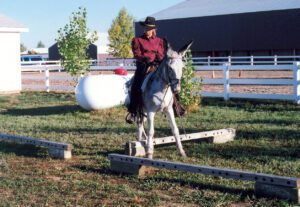
MULE CROSSING: Donkey Training, Part 9
By Meredith Hodges Perfecting Lateral Techniques You have introduced your donkey to some lateral techniques both in the arena and over obstacles, and you are perhaps discovering that he is a lot better at some things than he is at others. You might find that he quits trying and goes through the bridle, going straight instead of laterally. You must understand that lateral work is very taxing for your donkey’s muscles and will tire him quickly. When he gets tired, he will “run through the bridle” and refuse to move laterally. This will usually happen at the trot, but rarely at the walk. If you find your donkey behaving in this manner, it is best to go to walk and perform only one correct lateral move, then end the lesson there and resume it on another day when he is rested. Lateral work should really be done only once or twice a week at most. There should be at least three days between lateral sessions. This lesson will teach you some lateral exercises under saddle that will help your donkey be more responsive laterally. Up to this point, we have been schooling what is called leg yields, or lateral moves, on an angled track. We have begun movements to introduce the side-pass, which is a lateral move, only straight sideways. This is even more difficult for your donkey than the leg yields, since it requires a higher degree of crossing over from his legs. You may have found difficulty in negotiating the side-pass obstacles previously mentioned. First, check to make sure that the placement of your side-pass rail near the fence is correct. It should be about three quarters of your donkey’s length from the fence and lay parallel to the fence so that when he stands with his nose ...
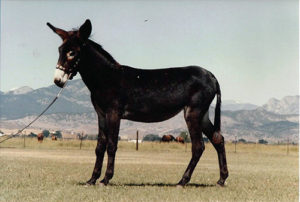
MULE CROSSING: Donkeys As Livestock Guardians
By Meredith Hodges There has been a lot of discussion since the early nineties around using donkeys for small livestock protection and predator control. Donkeys can certainly be a formidable opponent for cats and dogs and other smaller animals. One needs to be careful about who the donkey is pastured with since it is in their nature to pursue and sometimes kill animals that are smaller and weaker than them. This is true in all donkeys, although some individual females tend to be more maternal and are not apt to go after smaller livestock. The males will always be more aggressive than the females and do not make good guardians for smaller livestock. The other thing to consider is whether or not they have been raised with the livestock they are expected to guard. When raised with the other livestock, they will feel more a part of that “family” and are less likely to do them harm. A donkey that is going to be expected to guard livestock, but was not raised with them, should be carefully introduced to them “over the fence” for several weeks. Then if all seems to go well, you can introduce them in the same pen and watch for any signs of aggression. If there are signs of aggression after a few weeks of being separated, then they probably will never really get along. You must remember that a donkey is NOT a predator, nor a prey animal that will necessarily get along with other livestock. Donkeys prefer to be in a herd with other donkeys. They do not like being alone either. Donkeys have a strong sense of “family” and prefer to be with their own kind. When forced to be with other species, they will blend, but grudgingly. There are three basic sizes ...
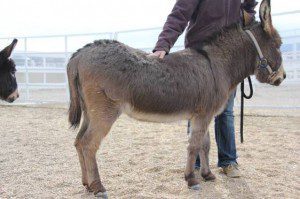
MULE CROSSING: Donkeys: The “Sinking” Reflex
Donkeys have a lot of behaviors that owners might find strange. One of these is dropping their spine, or “sinking,” when you put a hand on their back. Not all donkeys will do this, but many of them will, especially when they are young and or haven’t been handled routinely. I’ve personally had experience with donkeys sinking to the point that they’ll go down to the floor on their knees and bellies. You may also commonly recognize this behavior in cats and dogs. In order to understand what’s happening, it is important to understand the intervertebral equine anatomy. “Intervertebral” refers to the opening between two jointed vertebrae for the passage of nerves to and from the spinal cord. When a foal is first born, their bones and cartilage are soft and flexible, and their nerves in these areas are hypersensitive —especially over the spine. A foal that has not had the benefit of imprinting will be much more sensitive and generally reactive to touch than one that has been imprinted. Imprinting begins to desensitize nerve endings throughout the body wherever the animal is touched. However, the primary focus when imprinting is usually on the head, neck, ears, around the eyes, mouth, and down the legs, with only a passing swoop over the back and croup. Thus, the back does not get as much desensitization during imprinting and is largely ignored until grooming comes into the picture, and later, tack and equipment. As the foal ages, muscles begin to develop under and around the nerves thanks to ongoing exercise. When muscles get harder and toned, though still maintaining their elasticity, they put pressure on the nerves from the inside of the body. You will start to notice that the foal that used to “jump” out from under your touch ...
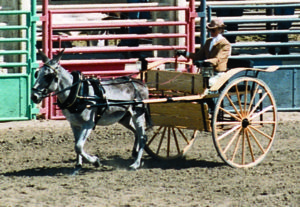
MULE CROSSING: Driving Activities
By Meredith Hodges With the introduction of the automobile came decreased interest in horse-drawn vehicles. Tractors replaced equine-driven vehicles in the fields. It seemed as if equines had been put out of a job! But, as with any change, this was only temporary. Modern society still has need of equine participation, especially from donkeys and mules. The well-schooled driving donkey or mule is much safer and more reliable than any horse. The reason for this is the donkey and mules' natural sensibility and their positive response to verbal communication. Once they have learned the parameters of their job, if treated fairly, they will calmly and diligently go about their business, flicking their ears back and forth toward the driver, always listening for verbal reinforcement of their behavior. In a pinch, they can more often be prevented from "freaking out" with a few calm and reassuring words. Their strength and durability enables them to work longer and harder hours than can a horse and their variety of sizes and colors provides them as suitable driving animals for a number of driving-related activities. Most often we see driving animals in parades. Although it seems simple enough to drive down a parade route, there are a number of things to consider that can complicate the issue. Parade routes are lined with potential hazards and an overload of outside stimuli. Horses that become spooked have been known to bolt and actually run right through crowds of people. I have yet to hear of a donkey or mule that has done such a thing! Perhaps it is because the donkey or mule will not run into trouble if he can possibly avoid it. He will also be more likely to rely upon his driver for support and direction through the safest route. He will stop ...
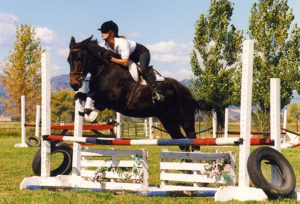
MULE CROSSING: Equine Behavior: Look Who’s Talking! Part 3
By Meredith Hodges In Part 1 of Equine Behavior: Look Who’s Talking, we discussed the evolution of man’s self-discovery and how he applied this to his approach to equines. If we want to manage our equines in a healthy way and accomplish even the most basic performance with them, there is much to consider during the training process. In Part 2 of Look Who’s Talking, we learned that equines are honest in nature and produce quick and honest reactions to a stimulus. Therapeutic Riding provides an exemplary teaching experience for both human and equine, and those of us with our own equines can now derive much more from the relationship than we ever thought possible. During centuries of use, equines have been asked to perform many tasks, as they have always been essential tools in agriculture, for transportation in cities and as a fighting partner in the military. People who worked regularly with these animals had an appreciation for their general health and longevity. Although people were limited by their own experience, they would generally provide the best possible care because the equine was an integral part of their economy. Many horses and most mules and donkeys worked hard to build this world and support people in their endeavors. It is always amazing when one realizes just how much these animals have contributed to our wealth and welfare. Original dressage training was concerned with the systematic conditioning of the body of the horse in a way that would make him a durable and viable war partner for soldiers. The horse was revered and allowed time for his body to mature and grow slowly. The training followed suit, yielding a healthy and formidable opponent in any competition. This goal was achieved only when the animal was trained in correct posture, and ...
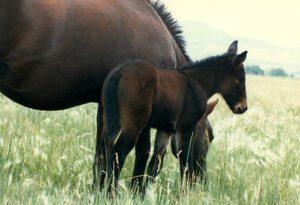
MULE CROSSING: Establishing Management Practices for N.I. (Neonatal Isoerythrolisis)
By Meredith Hodges Establish a regular routine for feeding and management to avoid stressing pregnant mares and equines in general. Make your routine predictable. Mules are cheaper to keep than horses. They are more durable animals and are more resistant to parasites and disease. They require less feed and lower protein to maintain good health. They are intelligent in potentially dangerous situations and will avoid harm to themselves. They require less hoof care than horses in many instances. Under reasonable conditions, trims are sufficient. Shoes are not necessarily needed. But as tough as they may be, they still need quality care and management. Your equine depends upon you for his safety and well-being. The best feed in the world won’t keep him in good health if you neglect other important things such as vaccinations and worming. It’s up to you to create a program to prevent disease and control parasites. Cleanliness is very important. Make sure feed boxes are clean and manure is removed from stalls and paddocks. Do not feed hay or grain on the floor or anywhere it may become contaminated with manure. Similarly, small, heavily used pastures tend to build up a heavy parasite load. Pastures should be rotated and harrowed as frequently as possible to break the life cycle of the parasites. We never graze our equines on the fields we use for harvesting hay. Internal parasites are the most common danger to the health and well-being of your equine. Consult with your veterinarian to set up a parasite prevention and control program. At the Lucky Three Ranch, we worm every eight weeks in January, March, May, July and September with Ivermectin, and then break the cycle with Strongid in November. Always keep an eye out for anything that might injure your equine, and remove or ...
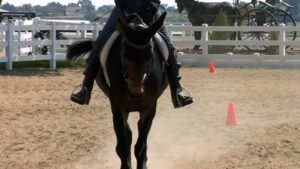
MULE CROSSING: Fine-Tuning the Aids
By Meredith Hodges While doing the exercises in balance by riding without the aid of your reins as described in DVD #5, you probably discovered a lot more shifting of your own balance than you imagined. This nearly imperceptible shift of balance, however, can grossly affect the balance of your equine. Until now, I have always given the rider a visual point of reference by allowing you to glance down at the outside front leg. Now you will want to be more inwardly conscious of your own body position. You need to repeat many of the previous exercises to cultivate this kind of sensitivity, but this time, close your eyes for brief periods of time to get the “feel” of each movement in your own body. Do not simply allow your equine to travel freely in any direction, because this will not give you an accurate feeling for any specific gait or task—you must plan your course of action. If, for instance, you set up your equine to bend through and come out of a corner with impulsion, you can close your eyes for a few seconds down the long side and feel the balance that comes out of that corner when the movement is executed correctly. In this particular situation, once you’ve closed your eyes, you may notice that your animal is starting to lean slightly to the inside. A squeeze/release from your inside leg, sending your mule forward and catching that balance with the outside rein, corrects the balance and keeps him going straight and erect down the long side. Your seat bones are closest to your body’s center of gravity, making them the best sensors for balance. “Feel” the weight shift from one seat bone to the other through turns and circles, and then even out as ...
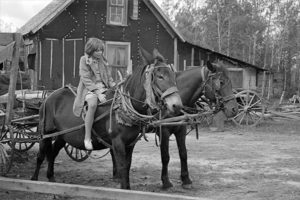
MULE CROSSING: From Mules to Riches
By Meredith Hodges Long before the Founding Fathers drafted our constitution, America began as a religious nation under God, and the mule has his roots in religion just as does the country he has helped to build. The mule of today’s ancestor is the donkey, mentioned in the Bible numerous times as an animal respected by God and blessed by Jesus Christ. The donkey was even chosen to bring Mary and Joseph to Bethlehem and, later, acted as the mount Jesus himself used for his ride into the city of Jerusalem. Here is an ancient story, quoted directly from the Bible, illustrating the mule’s wonderful sense of humor: “So Zadok the priest, and Nathan the prophet, and Benaiah the son of Jehoiada and the Cherethites, and the Pelethites, went down and caused Solomon to ride upon king David’s mule, and brought him to Gihon.” I Kings 1:38 “And Absolom met the servants of David. And Absolom rode upon a mule, and the mule went under the thick boughs of a great oak, and his head caught hold of the oak, and he was taken up between the Heavens and the earth, and the mule that was under him went away.” II Samuel 18:9. Mules are the true professionals of slapstick humor and professional psychotherapy! When you get into an altercation with a mule, you will seldom get hurt, but you will surely be set straight in a most humiliating way. In the early days of what was to become the United States of America, mules and horses perpetuated the expansion of the colonists into the Western territories of America. Since these early times, the American mule has acted not only as a pack animal for miners and fur traders penetrating the West, but it has also played an important part ...
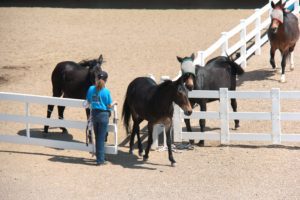
MULE CROSSING: Gate Training
By Meredith Hodges Learning to go through a gate with respect and consideration for the handler is an important lesson for your equine to learn. Your considerate and consistent approach to retrieving him from his stall, pen or pasture can make all the difference in safety and pleasure for you both. This begins from the time you take him from his stall. Do not go into his area, but rather, ask him to come to you. If you have been consistent rewarding your equine from your fanny pack with the same oats he gets fed every evening, this should not pose a problem. The reason for feeding the oats in the evenings is so he is given the motivation to come back in during the spring months when pasture time must be limited. Feeding only grass hay in the morning gives him incentive to come to you to be haltered for lessons, as he knows his efforts will be rewarded with extra oats. Use verbal commands to “come on!” prefaced by his name. This reinforces his response to verbal commands and familiarity with his name. This will come in handy when you need to fetch him from a pen of multiple animals. Going through a gate seems simple enough, but you can really get into trouble if it is not done correctly. Ask your mule to follow your shoulder to the gate and halt squarely, and then reward him (crimped oats) for standing quietly while you unlatch the gate. When going through the gate, if possible, the gate should always open away from you and your mule. When the gate is hinged on the left, transfer your lead line from your left hand (showmanship position) to your right hand, and open the gate with your left hand. Switch positions if ...
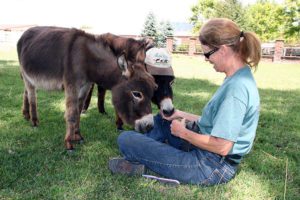
MULE CROSSING: Getting Down with Minis, Part 1
By Meredith Hodges Miniature horses, donkeys and mules all have one thing in common; everyone else is taller than they are! That makes eye contact with the trainer very difficult if not impossible for them. As the saying goes, the eyes are the window to the soul so it is understandable that they would become anxious if they are unable to look into a person’s eyes to decide whether they are friend or foe. I have five miniature equines: a mini horse named Mirage, a mini mule named Franklin, a mini molly mule named Francis, and two mini donkeys named Augie and Spuds. To help them all succeed and thrive, I’ve structured my training program for them based on the same one I use for all of my other equines, with one important modification. With safety always as my first priority, I work with my minis from a lower position whenever it’s safe to do so. That way, I can make eye contact with them, and I make certain they are always lavishly rewarded with an oats reward for their compliance. The results have been amazing! I’ve received total cooperation from them almost all of the time. None of my minis were born at my ranch, so I knew that they would each first need to explore their surroundings a little at a time, and would also need ample time to get used to my staff and me. Mirage, the miniature horse, was my first mini. It wasn’t long after I acquired him that I acquired Franklin, the mini mule, who quickly became Mirage’s buddy. Since both Mirage and Franklin had previous training and because minis seem to accept training more willingly when done with a partner, we did all of Mirage’s and Franklin’s groundwork lessons together and, true to form, they learned very ...
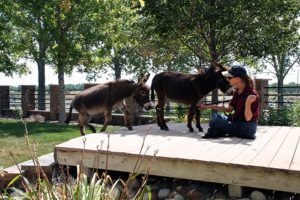
MULE CROSSING: Getting Down with Minis, Part 2
By Meredith Hodges In Part 1 of this article, you learned how to begin your relationship with your miniature equine in a positive and natural way, and how “getting down” to their eye level so they can make eye contact with you discourages striking, jumping on you and other bad behaviors that are common when working with miniature equines. Be sure you have successfully completed the lessons in Part 1 before moving on to the lessons in Part 2 or training may not yield the desired positive results. Also, if possible, it is best to work minis in groups if they are used to being with other equines, as they perform better when they are with their “friends” and it doesn’t hurt to train their friends in the same way. Let’s begin with something you and your mini will experience on a regular basis: a visit from the farrier. First, lead your mini to the work station (as described in Part 1). When you get to the work station, tie up your mini and sit on the floor with him (as you did in the pen). Now you will be having a “picnic” (as you did in Part 1), but this time you will be in the work station and you will have a guest…the farrier. Before the farrier attempts to pick up the first foot, ask him to sit down beside your mini in front of the shoulder on the left side and offer a handful of oats as a way of introducing himself. Next, while you sit at your mini’s head and offer the oats reward for good behavior, have the farrier begin with the near side (left) front foot and work his way around from front to back, and then from back to front on the other ...
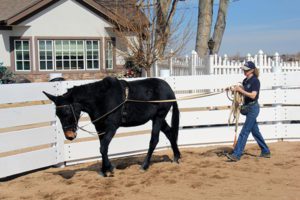
MULE CROSSING: Good Basic Training Includes Common Sense, Part 4
By Meredith Hodges In Part3, your equine was properly strengthened and balanced in good posture during the more passive exercises in leading training over obstacles. Now, in the fourth and final part of this article, you and your equine will head to the round pen and learn how to balance correctly on the circle at the faster gaits. You’ll also learn the more advanced and quicker moves that are required under saddle and in harness. Only after you have adequately completed lead line flatwork and obstacle training is your equine truly ready to move on to the round pen and begin lunging and learning to balance on a circle at the more active gaits. At this stage, he should be complying willingly, walking with the lead rope slung over his neck and with his head at your shoulder. By now, his core muscles should be properly conditioned and strong enough to support his skeletal system during more active use and more complicated movements. Note: The equine that has not had this prior lead line balance and good posture training will have difficulty in the round pen because he has not learned to stay erect and bend his body through the rib cage when on arcs and circles. When you are lunging your equine, stand close to the center of the round pen, focus your eyes on the lower part of your equine’s haunches, and then give the verbal command to “Walk on.” Let your eyes and whip follow his haunches while you stand in the center of the round pen. If you want him to stop, say “Whoa,” and then move your eyes and body sideways so that you are more in front of him. Then raise your head and eyes to meet his eyes. If you want him to ...
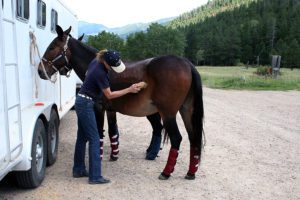
MULE CROSSING: Hauling Long Distances
By Meredith Hodges Hauling long distances needn’t be a problem with your Longears, if you use a little common sense and consideration. Their natural durability and good sense make them basically easier to haul than horses. When hauling for more than four or five hours, there are a few things to consider. Be sure to have your Health Papers and recent Coggins tests done for the trip. You will need them to cross state lines. If you need to carry firearms with you, be sure to look into the state laws for legal carrying. Make sure to have full insurance coverage on your truck and trailer and on miscellaneous items that you would be carrying like tack, equipment and camping gear. There are separate temporary policies you can get for those kinds of things. Insuring the equines themselves is often very expensive and they don’t tend to pay if something happens. Always carry a First Aid kit and tools to fix simple problems you might have with your truck and trailer, and know how to use them. First, you should be sure that the trailer in which they are to ride affords safety and comfort and that the plates on both the truck and trailer are up-to-date. Before you leave, you should check over your trailer thoroughly. Make sure the hitch is secure and in good repair, and that there are no weakened welds anywhere. Check your trailer’s tires, bearings, axels and brakes for maximum performance, and make sure all the lights are in working order. Take the trailer mats out and check the floor boards for rot and other weaknesses, and replace all floor boards that are even questionable. It is always good practice to get all new tires for the trip and a new spare. Using bedding such ...
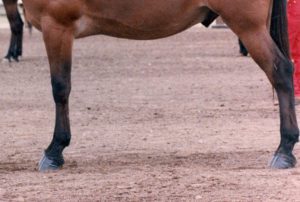
MULE CROSSING: Hoof Differences in Horses, Donkeys and Mules
By Meredith Hodges The old saying, “No foot, no mule” is literally true, as it is in any nomadic animal. If the hooves are not trimmed and balanced properly, it will offset the balance of the equine’s entire body and can compromise longevity in the animal because his entire internal structure will be compromised. Most equines will need to be trimmed or shod every 6-8 weeks whether horse, mule or donkey. Horse’s hooves in general are proportionately larger, rounder and more angled than that of the donkey or mule. The sole of the foot is flat on the ground promoting good circulation in the foot through the frog. Regardless of the size of the animal, the hooves of the mule will be smaller and more upright than that of a horse of equal size, and should be well sprung and supported, not contracted. They should have a smooth appearance and look sleek and oily. No ribbing should be apparent and the frog should be well extended, healthy and make adequate contact with the ground for good circulation to the hooves. The shape of the mule or donkey foot is more oval and the bottom of the foot is slightly “cupped” which accounts for the surefootedness in the mule and donkey. When being trimmed, the mule should be left with more heel than the horse to maintain the often more upright position that complements the shoulders and hips. If the mule or donkey has a better slope to the shoulders, he might have an angle that is similar to the horse, but he will still grow more heel than the horse. The shape and condition of the hooves of the jack and the mare are both equally important when considering foot development in the mule. Because donkey and mule hooves are ...
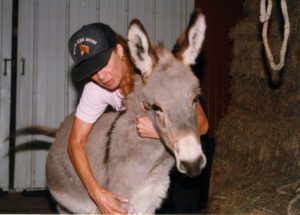
MULE CROSSING: Imprinting Beyond Birth
By Meredith Hodges Imprinting is defined as “rapid learning that occurs during a brief receptive period, typically soon after birth or hatching, and establishes a long-lasting behavioral response to a person or object as attachment to a parent or offspring.” 1 When we speak of “imprinting” in the scientific sense, it is a reference to the way the brain accepts input. The brain compartmentalizes impressions and images, and the animal reacts to the stimulus that the image produces. A collection of “imprints and images” produces memories. Imprinting training with a foal of any breed will give him a jump-start on his life with human beings. Imprinting is more than getting your foal used to people. He’s going to spend the rest of his life with human beings, so he should get used to your touch, your voice, your smell and, especially, your handling of him. Handling your foal the minute he is born is a wonderful way to bond with him, and you will learn how he likes to be touched in order to produce a positive response. This early imprinting lays a foundation of trust for the training to follow. Although it is commonly accepted that initial imprinting on the foal’s brain occurs only during a brief receptive period when initial contact is made during the first few days of life, it does provide a foundation on which to expand exposure to a human being through your foal’s five senses of touch, taste, smell, hearing and sight that leave impressions on the equine brain and will affect the way he interacts with a handler beyond what his dam may teach him. If the initial contact with humans leaves a positive impression, a foal will be more likely to be curious about humans than afraid of them. Because of this ...
